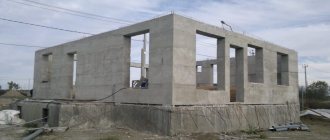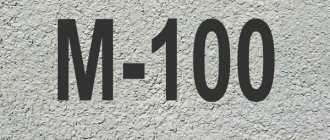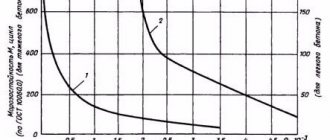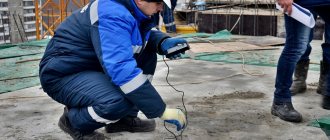Every year, millions of cubic meters of concrete and reinforced concrete waste are generated around the world.
And the annual increase in scrap expected in Russia alone from the accumulation of defective structures and from the dismantling of old buildings is equivalent to 15-17 million tons.
Most of this type of construction waste is disposed of in landfills, including unauthorized ones, located in urban areas.
Such actions negatively affect the environmental situation, so large cities need to use technologies for recycling concrete residues.
The economic justification for recycling scrap is to reduce the cost of products from waste and free up space.
Definition
The category includes residues generated during the production of commercial products by enterprises in the construction industry - concrete and reinforced concrete:
- defects from the production of products with cracks, chips;
- technological waste;
- concrete dust;
- dried and liquid solutions.
Concrete and reinforced concrete residues (RCR) are also generated in the construction industry, including :
- New construction;
- reconstruction and repair of facilities;
- demolition and dismantling of outdated, dilapidated, emergency buildings and structures.
Construction concrete waste consists of pieces of different sizes and shapes, scrap, and broken products.
These include fragments :
- structures of obsolete buildings;
- road slabs;
- piles;
- supports
The category also includes concrete waste and concrete waste from the reclamation of industrial and natural landfills.
What is concrete waste?
Reinforced concrete products are intended for the construction of buildings. These are reinforced concrete slabs of large sizes. Waste in this category is generated by:
- construction of buildings;
- demolition of an emergency building;
- dismantling structures made of concrete and reinforcement.
Reinforced concrete waste is produced by construction companies, enterprises producing reinforced concrete blocks (structures), and individuals dismantling small buildings on private territories.
The amount of accumulated waste reinforced concrete products is constantly growing. Despite the fact that the hazard class of concrete waste is fifth (non-hazardous), it is advisable to dispose of them, since processing (disposal) reduces the area of litter and makes it possible to obtain recyclable materials.
FCKO
According to the Federal Classification Catalog of Waste (FKKO), the remains of concrete and reinforced concrete belong to the blocks:
- block 3 “Waste from processing industries” (FKKO code 30000000000);
- block 4 “Consumer waste, materials and products that have lost their consumer properties” (FKKO code 40000000000);
- block 8 “Construction and repair waste” (code 80000000000).
Classification of waste related to block 3:
| Type | Waste | Subtypes | Waste | Groups, subgroups | Waste |
| 34000000000 | Production of other non-metallic mineral products | 34600000000 | Production of concrete, concrete products | 34610000000 34611000000 34612000000 | Production of ready-mixed concrete, dry concrete mixtures |
| 34620000000 | Production of concrete products for use in construction |
Classification of waste concrete and reinforced concrete that has lost its consumer properties (block 4 of the FKKO):
| Type | Waste | View | Waste |
| 45000000000 | Other non-metallic mineral products | 45841111525 | Concrete targets in a cardboard shell |
Block 8 includes the following waste related to construction and repairs:
| Type | Waste | Subtypes | Waste |
| 81000000000 | Preparation of the construction site, dismantling and demolition of buildings | 81900000000 | Others |
| 82000000000 | Construction of buildings and structures | 82200000000 | Based on concrete, cement, mortars |
| 82900000000 | Others |
Hazard classes
In accordance with the FKKKO classifier, concrete and reinforced concrete waste belongs to the following hazard classes.
Waste from processing industries (block 3):
| Waste category | FKKO codes | Name of waste | Hazard Class |
| Production of concrete and concrete products | 34611214214 | Hardened lime mortar, lump form | 4 |
| 34611511214 | Production of ready-mixed concrete:
| 4 | |
| 34611513215 |
| 5 | |
| 34611713394 34611714394 34611715394 |
| 4 | |
| 34611811214 34611812215 |
| 4 5 | |
| 34612001424 | Concrete mixture in the form of dust | 4 | |
| 34612111495 | Sand screening | 5 | |
| 34620001205 34620002205 | Production of products for use in construction:
| 5 | |
| 34620003424 |
| 4 | |
| 34621111394 34621112204 |
| 4 |
Construction and repair waste (block  :
:
| Waste category | FKKO codes | Name of waste | Hazard Class |
| Dismantling and demolition of buildings | 81991111704 | A mixture of solid products and materials, predominantly containing concrete | 4 |
| Construction of structures and buildings | 82202112495 | Loose dry concrete mixture | 5 |
| 82220101215 82230101215 | Pieces of waste concrete, reinforced concrete and scrap products | 5 | |
| 82221111204 | Solid concrete scrap for construction and repair of industrial buildings | 4 | |
| 82223111204 82233111204 | Solid waste of concrete and reinforced concrete contaminated with petroleum products | 4 | |
| 82291111204 | A mixture of solid scrap concrete and reinforced concrete for dismantling building structures | 4 | |
| 82913111205 | Wooden formwork contaminated with concrete | 5 | |
| 82915111624 | Duplicated textile fiber materials for construction contaminated with concrete | 4 |
From the above sample it is clear that concrete and reinforced concrete waste have hazard classes:
- 4 - low-hazard waste, with a low level of harmful impact on the environment;
- 5 – practically non-hazardous, with very low environmental impact.
Construction waste of hazard class 4, except for coarse and large-sized objects, is taken to landfills, which worsens the environmental situation .
At the same time, scrap concrete is a valuable secondary raw material, the processing of which into crushed stone allows reducing investments in the construction of new facilities, at the same time reducing the load on city landfills and eliminating the movement of construction waste to unauthorized landfills.
Sale of secondary crushed stone
Processing of scrap reinforced concrete products and concrete waste is a profitable production. Enterprises that recycle reinforced concrete structures profitably sell the resulting building material. Raw materials are purchased from such companies in bulk.
Reception of crushed concrete, recycling, and sales are carried out by one enterprise. To organize such work it is required:
- permission for disposal and recycling;
- transport for delivery of reinforced concrete scrap;
- storage and processing facilities;
- stationary (mainly) or mobile equipment;
- compliance with safety rules.
Less often, intermediaries deal with the sale of recycled crushed stone. In this case, the cost of recyclable materials is higher than that of the manufacturer.
Construction companies, building materials stores, road companies, and individuals buy materials after processing.
Recycling waste concrete and reinforced concrete
Recycling construction waste is profitable and economical. Often, when old buildings are demolished, a new building is erected in the same place, requiring a large amount of crushed stone. The material can be obtained from scrap concrete. Preparing concrete using recycled crushed stone reduces its cost by 25%.
Several ways of processing concrete and reinforced concrete residues are used in the world:
- After the structures are dismantled, the waste is transported to a facility to produce a secondary product, which is then sent to a concrete plant.
- Recycling of concrete waste is carried out at the site of dismantling work using installed equipment. The resulting product is sent to a construction site or concrete production plant.
- Recycling of scrap concrete and the production of new products based on it is organized directly at the site of dismantling work.
In domestic processing practice, the second or third options are predominantly used.
Concrete recycling
Technological equipment for processing substandard concrete includes the following types of installations :
- destruction or primary crushing;
- secondary crushing;
- fractionation.
Crushing of concrete waste is carried out using stationary or mobile (self-propelled) installations. Operation on stationary devices has a simple operating principle.
Waste enters the receiving bin and is sorted. Then they are crushed in a crusher. Next, the concrete mass is divided into fractions on a screen - crushed stone and sand . Large debris that is not sorted is returned to the crusher.
The main disadvantages of stationary crushers are their high price and bulkiness, which does not allow the installation to be transported outside the processing plant.
If it is impossible or ineffective to use stationary crushing and screening complexes, mobile type installations are used . The waste recycling process is similar to stationary devices.
Recycling of reinforced concrete
Reinforced concrete waste (RCW) contains concrete and metal reinforcement, which must be separated from each other .
Therefore, the design parameters of technological equipment for processing reinforced waste must be selected taking into account the presence of reinforcement in the scrap and the impossibility of maintaining the exact dimensions of the supplied material, as well as controlling the shape of the fragment.
Due to this fact, some units of crushing mechanisms for processing reinforced concrete are much larger than similar units of installations for crushing concrete scrap that have the same productivity.
When destroying reinforced concrete materials, methods are used:
- mechanical (splitting, impact destruction, crushing, cutting);
- non-mechanical (destruction - electric pulse, electrohydraulic, explosive; cutting - thermal, water jet).
The most expedient method of destruction, both from a technological and economic point of view, is the mechanical method.
In world practice, the most popular types of crushers for reinforced concrete waste are rotary and jaw crushers. The impact rotor installation, designed for primary crushing of reinforced waste materials, due to the design features of the feed, is capable of crushing material of only limited sizes. Therefore, the extended reinforcement will not fit around the rotor of such a crusher.
significantly from impact crushers . There are no obstacles that impede the passage of reinforcement. The destruction of reinforced concrete is efficient. For example, to dismember scrap of dense reinforced concrete (piles, sleepers, pillars, slabs), vibrating jaw-type crushing units are used.
The reinforcement is destroyed along the welded seams, being well cleaned from the concrete. The metal is sent for remelting, and the concrete part, consisting of crushed stone and cement stone, is sent for the production of crushed stone or crushing of the stone to cement coarseness.
Reinforcement products removed from concrete are removed using:
- magnetic drums;
- stationary magnets;
- magnetic above-conveyor separators.
After the initial crushing of reinforced concrete, large parts of reinforcement are removed from the upper layer using a magnetic separator, and small debris from the lower layer of material is collected with a magnetic drum.
Features of recycling of reinforced concrete structures, structures and products
Preparing concrete structures for disposal or processing occurs as follows:
- gradual dismantling or demolition of a building or part thereof;
- cutting concrete slabs and reinforcement into pieces;
- collection, sorting, stacking of received items before delivery;
- transportation of scrap to a place of temporary storage or processing.
To demolish or disassemble a structure or part of it, it is necessary to follow technology and use heavy equipment (large volumes).
Disposal of concrete waste with iron elements is carried out using equipment located at enterprises
for processing. After recycling, building materials are obtained at a price and quality slightly lower than the original ones, but suitable for use.
Formed products and their application
After crushing concrete scrap, secondary crushed stone is formed - a loose mixture of granular material of different fractions and different shapes.
On the screen of the crushing and screening plant, the pieces are divided into 2 main fractions with sizes: 40-150 mm and 0-40 mm. The strength characteristics of crushed stone depend on the source material being crushed.
Recycled crushed stone is used for manufacturing:
- Concrete mixtures for the production of concrete blocks for basement walls.
- Concrete wall stones.
- Foundation slabs.
- Bases for road surfaces, platforms.
- Underlayment layers during the construction of sidewalks.
Crushed stone is also used in landscape architecture or as backfill to replace missing soil during construction work.
The fine fraction in the form of screenings up to 5 mm in size is used as an active organomineral additive . Pulverized filler is used as a filler in the manufacture of mortar.
Crushed waste of cellular concrete is used as fillers in mortars, fertilizers, and added to feed in poultry farms.
Finnish technology involves the use of water and aggregate washed from waste to produce new concrete. And finely dispersed sludge containing a large amount of calcium oxide is used in the agricultural industry for liming soils.
The essence of recycling technology
The technological process of recycling concrete products consists of the step-by-step implementation of the following actions:
- Before loading into the crushing complex, large fragments of concrete must be crushed to suitable sizes. For this purpose, hydraulic shears are used.
- The crushed concrete is loaded into the hopper, then the crusher is started.
- After grinding is completed, all processed material falls onto a sieve. Through it, secondary crushed stone is sifted out by vibration. Metal inclusions remain on the mesh.
The technology of separating crushed stone from metal using a sieve is classified as traditional. Among the latest developments in the processing of reinforced concrete products there are crushing complexes, the operation of which is based on screening using magnets. This improves the quality of work. The use of electromagnetic systems is rational to separate inclusions.











